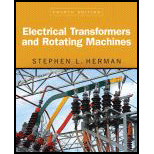
Electrical Transformers and Rotating Machines
4th Edition
ISBN: 9781305494817
Author: Stephen L. Herman
Publisher: Cengage Learning
expand_more
expand_more
format_list_bulleted
Concept explainers
Textbook Question
Chapter 4, Problem 10RQ
A transformer has a turns ratio of 1:6. The primary current is 18 amperes. What is the secondary current?
Expert Solution & Answer
Trending nowThis is a popular solution!

Students have asked these similar questions
A piston-cylinder device initially contains 0.4 kg of nitrogen gas at 160 kPa and 140°C. Nitrogen is now expanded isothermally to a
pressure of 80 kPa. Determine the boundary work done during this process. The properties of nitrogen are R= 0.2968 kJ/kg-K and k=
1.4.
N₂
160 kPa
140°C
The boundary work done during this process is
KJ.
!
Required information
An abrasive cutoff wheel has a diameter of 5 in, is 1/16 in thick, and has a 3/4-in bore. The wheel weighs 4.80 oz and
runs at 11,700 rev/min. The wheel material is isotropic, with a Poisson's ratio of 0.20, and has an ultimate strength of 12
kpsi.
Choose the correct equation from the following options:
Multiple Choice
о
σmax=
(314) (4r2 — r²)
-
о
σmax = p² (3+) (4r² + r²)
16
σmax =
(314) (4r² + r²)
σmax =
(314) (4² - r²)
I don't know how to solve this
Chapter 4 Solutions
Electrical Transformers and Rotating Machines
Ch. 4 - What is a transformer?Ch. 4 - What are common efficiencies for transformers?
Ch. 4 - What is an isolation transformer?Ch. 4 - All values of a transformer are proportional to...Ch. 4 - A transformer has a primary voltage of 480 volts...Ch. 4 - If the secondary of the transformer in question 5...Ch. 4 - Explain the difference between a step-up and a...Ch. 4 - A transformer has a primary voltage of 240 volts...Ch. 4 - A transformer has an output of 750 VA. The primary...Ch. 4 - A transformer has a turns ratio of 1:6. The...
Ch. 4 - Prob. 11RQCh. 4 - Prob. 12RQCh. 4 - Prob. 13RQCh. 4 - The primary leads of a transformer are labeled 1...Ch. 4 - The local utility company must provide service to...Ch. 4 - Refer to Figure 4-79 to answer the following...Ch. 4 - Refer to Figure 4-79 to answer the following...Ch. 4 - Refer to Figure 4-79 to answer the following...Ch. 4 - Refer to Figure 4-79 to answer the following...Ch. 4 - Refer to Figure 4-79 to answer the following...Ch. 4 - Refer to Figure 4-79 to answer the following...Ch. 4 - Prob. 7PCh. 4 - Prob. 8P
Knowledge Booster
Learn more about
Need a deep-dive on the concept behind this application? Look no further. Learn more about this topic, mechanical-engineering and related others by exploring similar questions and additional content below.Similar questions
- I am not able to solve this question. Each part doesn't make sense to me.arrow_forwardExercises Find the solution of the following Differential Equations 1) y" + y = 3x² 3) "+2y+3y=27x 5) y"+y=6sin(x) 7) y"+4y+4y = 18 cosh(x) 9) (4)-5y"+4y = 10 cos(x) 11) y"+y=x²+x 13) y"-2y+y=e* 15) y+2y"-y'-2y=1-4x³ 2) y"+2y' + y = x² 4) "+y=-30 sin(4x) 6) y"+4y+3y=sin(x)+2 cos(x) 8) y"-2y+2y= 2e* cos(x) 10) y+y-2y=3e* 12) y"-y=e* 14) y"+y+y=x+4x³ +12x² 16) y"-2y+2y=2e* cos(x)arrow_forwardQu. 15 What are the indices for the Plane 1 drawn in the following sketch? Qu. 16 What are the Miller indices for the Plane shown in the following cubic unit cell? this is material engineering please show all workarrow_forward
arrow_back_ios
SEE MORE QUESTIONS
arrow_forward_ios
Recommended textbooks for you
 Electrical Transformers and Rotating MachinesMechanical EngineeringISBN:9781305494817Author:Stephen L. HermanPublisher:Cengage Learning
Electrical Transformers and Rotating MachinesMechanical EngineeringISBN:9781305494817Author:Stephen L. HermanPublisher:Cengage Learning Refrigeration and Air Conditioning Technology (Mi...Mechanical EngineeringISBN:9781305578296Author:John Tomczyk, Eugene Silberstein, Bill Whitman, Bill JohnsonPublisher:Cengage Learning
Refrigeration and Air Conditioning Technology (Mi...Mechanical EngineeringISBN:9781305578296Author:John Tomczyk, Eugene Silberstein, Bill Whitman, Bill JohnsonPublisher:Cengage Learning Understanding Motor ControlsMechanical EngineeringISBN:9781337798686Author:Stephen L. HermanPublisher:Delmar Cengage Learning
Understanding Motor ControlsMechanical EngineeringISBN:9781337798686Author:Stephen L. HermanPublisher:Delmar Cengage Learning

Electrical Transformers and Rotating Machines
Mechanical Engineering
ISBN:9781305494817
Author:Stephen L. Herman
Publisher:Cengage Learning

Refrigeration and Air Conditioning Technology (Mi...
Mechanical Engineering
ISBN:9781305578296
Author:John Tomczyk, Eugene Silberstein, Bill Whitman, Bill Johnson
Publisher:Cengage Learning

Understanding Motor Controls
Mechanical Engineering
ISBN:9781337798686
Author:Stephen L. Herman
Publisher:Delmar Cengage Learning
Fluid Mechanics - Viscosity and Shear Strain Rate in 9 Minutes!; Author: Less Boring Lectures;https://www.youtube.com/watch?v=_0aaRDAdPTY;License: Standard youtube license